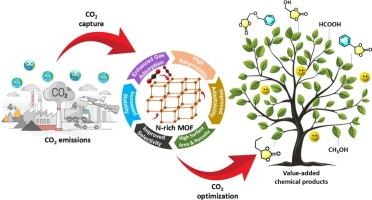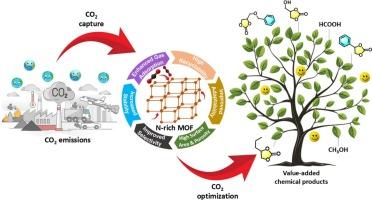用于二氧化碳封存和催化转化为增值产品的n基金属有机框架(mof)的新趋势:清洁能源解决方案的综合战略
IF 23.5
1区 化学
Q1 CHEMISTRY, INORGANIC & NUCLEAR
引用次数: 0
摘要
大气中二氧化碳浓度的持续上升已成为我们这个时代最严峻的挑战之一,对全球气候稳定、生态系统完整性和人类福祉构成了生存威胁。这一令人担忧的趋势要求我们迫切开发创新、高效和可持续的二氧化碳捕获技术,并将其转化为有价值的产品,作为全球追求碳中和的基石战略。富n金属有机骨架(mof)因其优异的孔隙度、结构可调性和功能多功能性而成为一种非常有前途的材料。本文综述了富氮mof在高效固碳和催化转化为高附加值化学品和燃料方面的研究进展。重点放在战略性设计方面,包括连接体功能化、金属节点选择和合成后修饰,所有这些都提高了吸附能力和选择性。此外,本文还讨论了开放金属位和Lewis碱基中心的结合作为提高CO2活化和催化效率的双重途径。特别关注氢化,电催化还原和环碳酸盐岩形成的最新突破,突出了这些转变的机制见解和结构功能关系。综上所述,吸附和催化的协同结合使富n mof成为碳中和技术和更广泛的循环碳经济的重要贡献者。本文章由计算机程序翻译,如有差异,请以英文原文为准。


Emerging trends in N-based metal–organic frameworks (MOFs) for CO2 sequestration and catalytic conversion into value-added products: An integrated strategy for clean energy solutions
The continuing rise in atmospheric CO2 concentrations has emerged as one of the most critical challenges of our time, posing an existential threat to global climate stability, ecosystem integrity, and human well-being. This alarming trend demands the urgent development of innovative, efficient, and sustainable technologies for CO2 capture and its transformation into valuable products, as a cornerstone strategy in the global pursuit of carbon neutrality. N-rich metal–organic frameworks (MOFs) have emerged as highly promising materials due to their exceptional porosity, structural tunability, and functional versatility. This review comprehensively explores the advances in N-rich MOFs for efficient CO2 sequestration and subsequent catalytic conversion into value-added chemicals and fuels. Emphasis is placed on strategic design aspects including linker functionalization, metal node selection, and post-synthetic modifications, all of which enhance adsorption capacity and selectivity. Furthermore, the integration of open metal sites and Lewis basic centers is discussed as a dual approach for improving CO2 activation and catalytic efficiency. Special focus is given to recent breakthroughs in hydrogenation, electrocatalytic reduction, and cyclic carbonate formation, highlighting the mechanistic insights and structure–function relationships underpinning these transformations. In summary, the synergistic combination of adsorption and catalysis positions N-rich MOFs as vital contributors to carbon-neutral technologies and the broader circular carbon economy.
求助全文
通过发布文献求助,成功后即可免费获取论文全文。
去求助
来源期刊

Coordination Chemistry Reviews
化学-无机化学与核化学
CiteScore
34.30
自引率
5.30%
发文量
457
审稿时长
54 days
期刊介绍:
Coordination Chemistry Reviews offers rapid publication of review articles on current and significant topics in coordination chemistry, encompassing organometallic, supramolecular, theoretical, and bioinorganic chemistry. It also covers catalysis, materials chemistry, and metal-organic frameworks from a coordination chemistry perspective. Reviews summarize recent developments or discuss specific techniques, welcoming contributions from both established and emerging researchers.
The journal releases special issues on timely subjects, including those featuring contributions from specific regions or conferences. Occasional full-length book articles are also featured. Additionally, special volumes cover annual reviews of main group chemistry, transition metal group chemistry, and organometallic chemistry. These comprehensive reviews are vital resources for those engaged in coordination chemistry, further establishing Coordination Chemistry Reviews as a hub for insightful surveys in inorganic and physical inorganic chemistry.
 求助内容:
求助内容: 应助结果提醒方式:
应助结果提醒方式:


